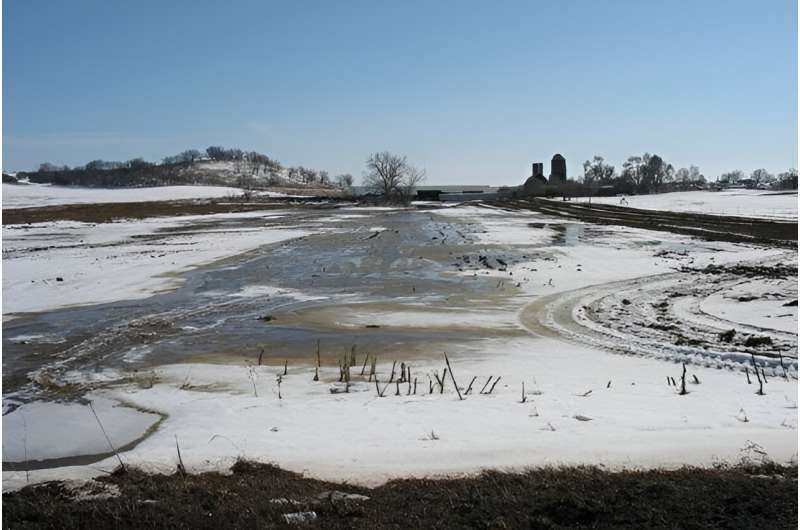This article has been reviewed according to Science X's editorial process and policies. Editors have highlighted the following attributes while ensuring the content's credibility:
fact-checked
trusted source
proofread
Study: Extreme rainfall increases agricultural nutrient runoff, conservation strategies can help

Nutrient runoff from agricultural production is a significant source of water pollution in the U.S., and climate change that produces extreme weather events is likely to exacerbate the problem. A new study from the University of Illinois Urbana-Champaign looks at how extreme rainfall impacts runoff and suggests possible mitigation strategies.
The research is published in the Journal of the Agricultural and Applied Economics Association.
"We look at more than a decade of precipitation events in the state of Wisconsin and quantify the increase in nutrient runoff right around the event and at the end of the growing season. Climate models predict that we'll continue to see an increase in extreme events, and our works speaks to the challenging relationship between nutrient use and water quality," said Marin Skidmore, assistant professor in the Department of Agricultural and Consumer Economics, part of the College of Agricultural, Consumer and Environmental Sciences (ACES) at U. of I. Skidmore is lead author of the study with coauthors Jeremy Foltz from University of Wisconsin-Madison and Tihitina Andarge from the University of Massachusetts-Amherst.
"Our focus on a single state allows us to accurately measure farm locations and practices, while keeping statewide regulation constant, in a way that would be difficult in a national study," Skidmore added.
Livestock manure and crop fertilizer are major causes of nonpoint source pollution from agriculture. Wisconsin has a large dairy industry, where most farms are below the federal definition of concentrated animal feeding operations (CAFOs) and therefore not regulated under the Clean Water Act. Instead, they are subject to a patchwork of local regulations.
The researchers studied water quality across nearly 50 watersheds in Wisconsin from 2008 to 2020. They correlated ammonia and phosphorus concentration data from the Water Quality Portal with the location of livestock farms and crop acreages, and they determined nutrient levels after half an inch, 1 inch, and 2 inches of rainfall.
They found spikes in nutrient concentrations immediately after extreme precipitation events, and the effect increased with the amount of precipitation. For example, within five days of an inch of precipitation, ammonia was 49% higher and phosphorus was 24% higher. If there was at least one day in a month with over an inch of precipitation, monthly ammonia was 28% higher and monthly phosphorus was 15% higher.
"We observe a significant interaction between rainfall, agricultural production, and runoff. It is not just a short-term spike in nutrient levels; at the end of the season, we still see persistent increases in phosphorus and ammonia attributed to those extreme precipitation events months earlier," Skidmore stated.
However, the researchers found that agricultural management practices can help mitigate the effects.
"Our results show that cover crops planted in the winter can lower the amount of nutrients in the water. Areas with cover crops have significantly lower spikes in ammonia and phosphorus, and the effect persists until the end of the growing season. We already know cover crops are great for soils and nutrient management, but this is additional empirical evidence showing that cover crops are climate-smart practices that can help agriculture be resilient into the future," Skidmore said.
The researchers also observed the presence of legacy nutrients, which are left behind from agricultural practices decades or even centuries ago.
"There is a direct impact of extreme precipitation on runoff that is unexplained by current activities. We attribute this to sedimented nutrients that remain in the soil from previous activities," Skidmore noted. "One of the best ways to deal with legacy nutrients is to ensure soils are healthy. By preventing soil erosion, you keep the legacy nutrients in the soil and out of surface water. These findings further support the use of management practices such as conservation tillage, vegetative buffer strips, and cover crops."
Wisconsin watersheds feed into North America's two largest river systems, the Mississippi and Great Lakes/St. Lawrence. Nutrient pollution can have acute local impacts, such as green algal blooms, which can be toxic to humans and animals. If people can't enjoy recreational activities like swimming or fishing, it leads to losses for local economies. Furthermore, downstream impacts continue along the Mississippi River into the Gulf of Mexico where nutrients contribute to a growing dead zone.
Finding solutions to dealing with nutrient pollution benefits the environment and society in general, Skidmore noted.
"Conservation strategies are not necessarily cost-effective for producers, so we must ensure there are policies in place to support their implementation. As we're approaching the next Farm Bill, there are discussions around how to allocate funds from the Inflation Reduction Act for climate-smart and conservation ag practices. It's important that such practices continue to receive funding so farmers can facilitate those benefits for all of us," she concluded.
More information: Marin Skidmore et al, The impact of extreme precipitation on nutrient runoff, Journal of the Agricultural and Applied Economics Association (2023). DOI: 10.1002/jaa2.90
Provided by University of Illinois at Urbana-Champaign





















